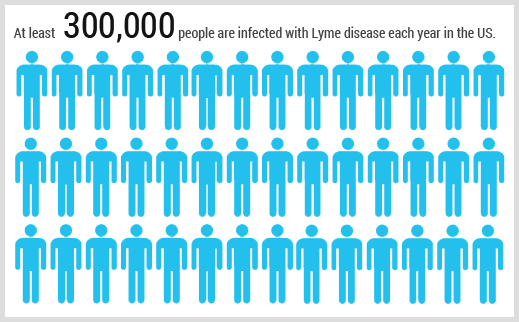Overview of Lyme Disease Treatment
The treatment for chronic Lyme disease is a controversial topic. Physicians who adhere to the International Lyme and Associated Diseases Society (ILADS) treatment guidelines believe symptoms are due to an active infection and should be treated with antibiotics beyond an arbitrary 30-day period.

At least 300,000 people are infected with Lyme disease each year
Clinicians following guidelines by the Infectious Disease Society of America (IDSA) claim that persistent symptoms are due to an overactive immune response, not an active infection. IDSA recommends stopping treatment after 30 days, regardless of whether or not symptoms remain.
Typically, there is no objective way of determining if the Borrelia burdorferi infection is active in symptomatic patients. And so, when evidence is uncertain and controversy exists, it is critical for the medical community to be able to evaluate conflicting positions – those of ILADS and IDSA.
“You have to examine whether you have prescribed appropriate antibiotics for each infection that might have been in that tick. The problem is that doctors are reluctant to treat any more than the bare minimum, and they lose the opportunity to treat people in a timely manner.” ─ Dr. Daniel Cameron
NBC News, 3/10/11
Only by airing these different points of view will the medical and scientific community reach a better understanding of controversial topics such as treatment of chronic Lyme disease. Meanwhile, physicians must be able to exercise their clinical judgment and patients should be provided with treatment options.

What Is Lyme Disease?
Lyme disease is a bacterial infection typically transmitted through the bite of an infected tick. It is one of the fastest growing infectious diseases in the country, and the steadily increasing number of cases has led many in the medical/scientific community and legislative arena to deem the disease a “public health crisis” and “epidemic”. learn more →

Our Treatment Approach
Our medical team treats patients according to ILADS’ guidelines, and in fact, Dr. Cameron is the lead author of those guidelines. Dr. Cameron has found that a one-time, short-term antibiotic treatment, as recommended by IDSA, is not effective for a large number of patients with chronic Lyme disease.learn more →

Choosing A Treatment
Lyme disease can become persistent, recurrent, and refractory, even with antibiotic therapy. Therefore, treatment should be prompt and thorough with in-depth follow-up to assess new symptoms and treatment response and to rule out other illnesses. learn more →



